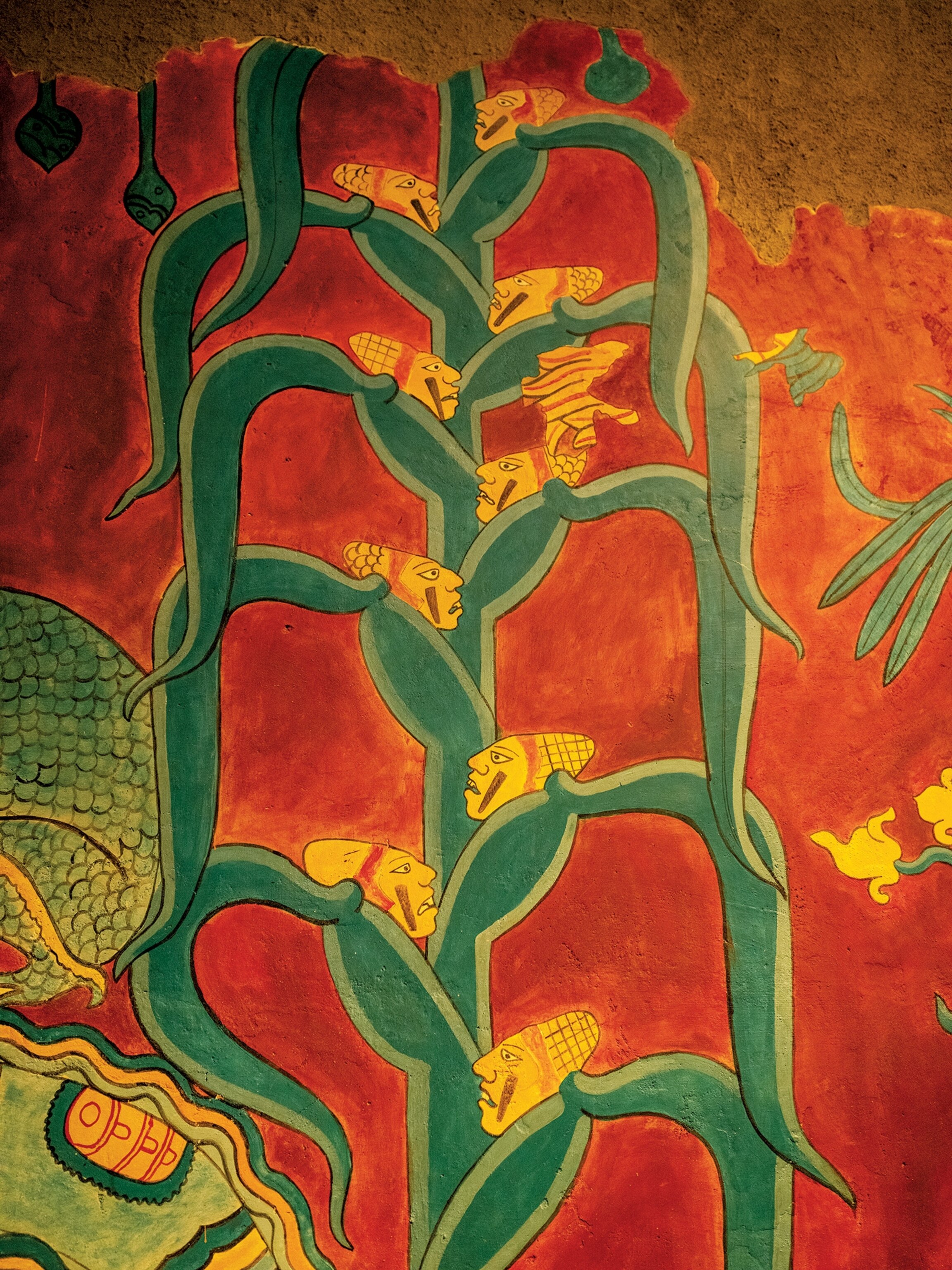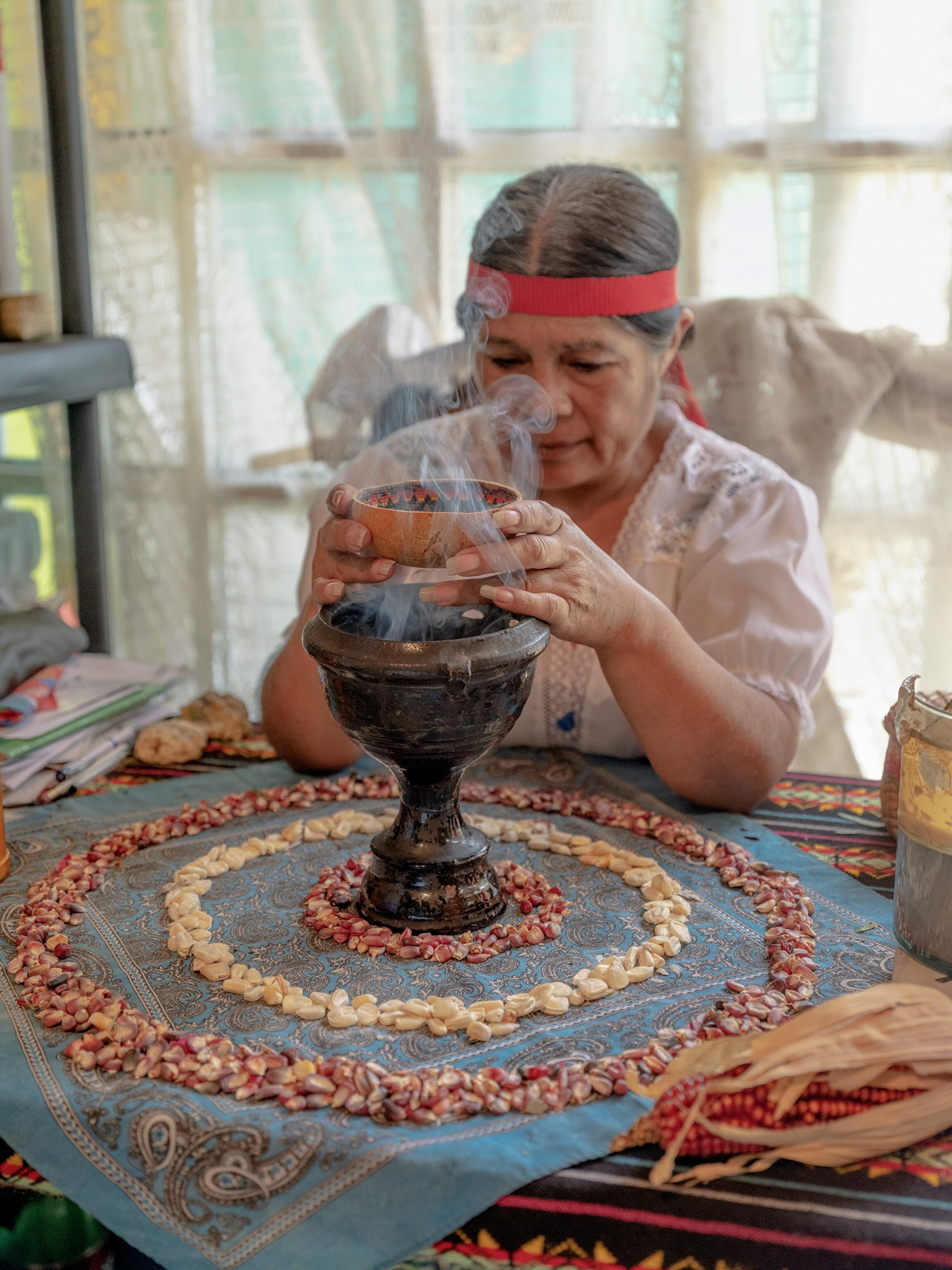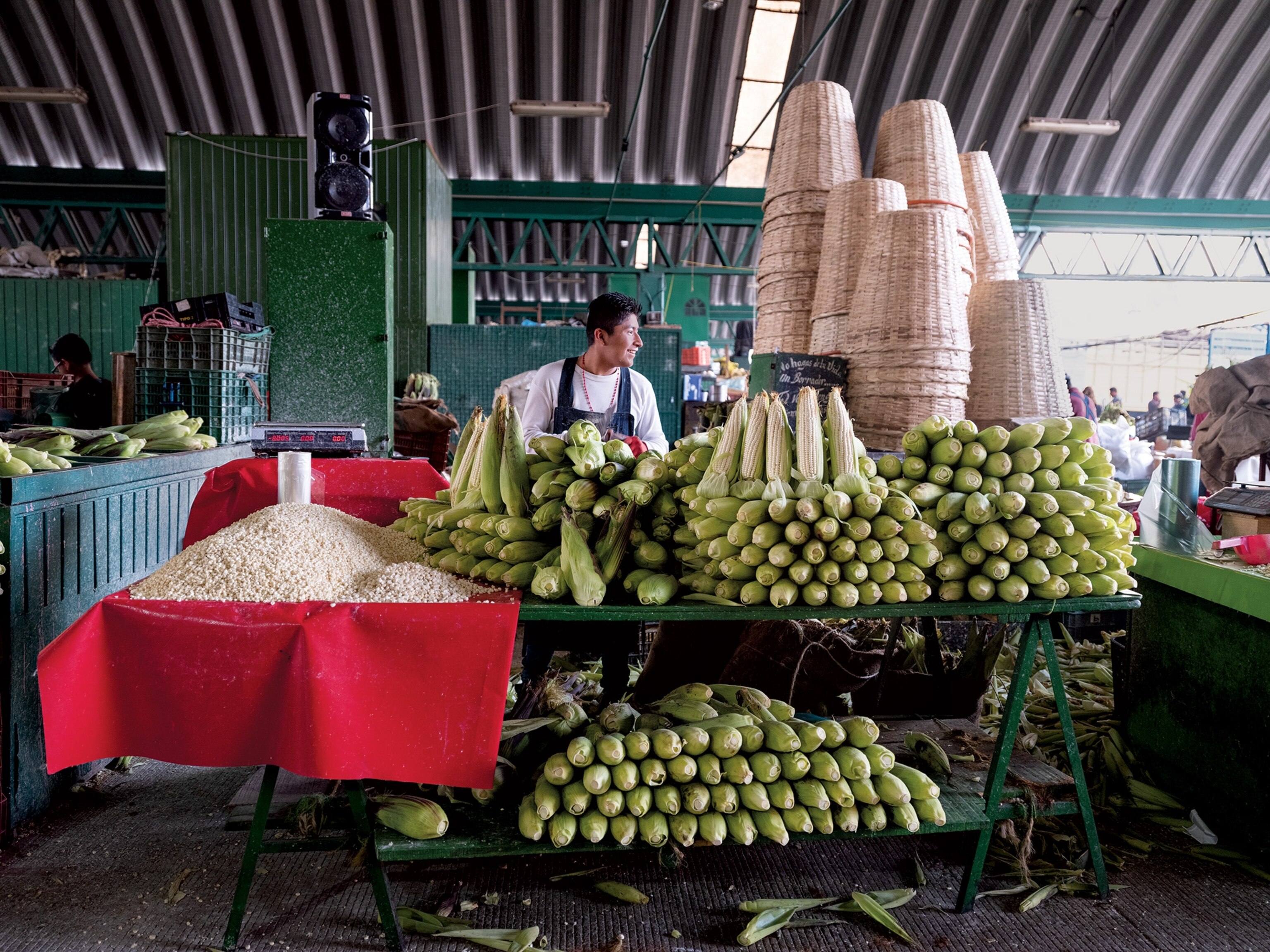It’s not difficult to find a hot, fresh tortilla in Mexico City.
There are thousands of family-run tortillerías that open onto the streets, where a half-dozen might cost the equivalent of a quarter. They seem delicious to someone like me, who is used to buying tortillas in a plastic bag at an Atlanta grocery store.
But, for the most part, the tortillas sold on the street and in stores in Mexico’s capital are made from a processed corn flour mix. They may seem like the real thing, but they are about as removed from the grain that has long sustained this country as a bucket of American popcorn is.
The real thing is what I had come to Mexico to discover.


My first lesson starts early. Rafael Mier, a middle-aged intellectual and farmer whose family manufactures chocolate, picks me up just after dawn one late-summer morning in Colonia Roma, west of the historic city center.
The neighborhood, with its late-19th-century European architecture, oyster bars, and coffee shops, is Mexico City’s equivalent of Manhattan’s Lower East Side. And like the Lower East Side, it doesn’t wake up this early.
We head southeast from the city to find the corn on which Mexico was built. Mier wanted to beat the traffic, which is a particular kind of beast here. A tangle of cars and trucks will appear out of nowhere, clogging streets that minutes earlier were clear as the sky. You can find yourself sitting for hours, your only relief a plastic bag of crunchy fried corn wheels doused with lime and salsa bought from a kid weaving in and out of traffic.

Corn is everywhere in Mexico, from those little roadside snacks to the perfect tamale served by a grandmother in the smallest village. Indeed, there is a saying in Mexico: Sin maíz, no hay país. It means without corn, there is no country. But to Mier and others who have dedicated themselves to saving corn culture, it’s increasingly the wrong kind.
He is intent on showing me the right kind, which is why we are pushing southeast against thousands of workers who are already pouring into this metropolitan area of 22 million people.
Our target is a sprawling farmers’ market in Ozumba, a town in the shadow of Popocatépetl, the volcano that erupted during the same time period that a 7.1 earthquake rocked the city in 2017.
There, he promises, we can find fat, fresh ears steaming in pots, dried cobs packed tight with speckled kernels that glow like gems, and big piles of blue corn kernels, ready to be transformed into masa and then tortillas. “This is the corn that is the soul of Mexico,” he tells me as we ease out of the city. “There’s no other food that is so important to an entire people.”



Corn was domesticated in south-central Mexico more than 8,700 years ago, and it spread throughout ancient Mesoamerica. In Puebla, a state that’s a 2.5-hour drive southwest of Mexico City, archaeologists found cob fragments in a cave they estimated to be between some 7,000-5,500 years old. Other evidence suggests that people cooked tortillas using a comal (griddle) in parts of Mexico as early as 500 a.d.
Today, it is a rare Mexican who doesn’t eat corn in some form every day. But most peoples’ meals are a far cry from the dozens of heirloom varieties that are the true culinary and cultural heart of Mexico, Mier says.
“In Mexico, the tortilla is like walking on the floor,” Mier says. “People don’t even think about it. But the pleasure of a real tortilla is getting lost. And if we lose the tortilla, we have lost Mexico.”
Modern agricultural practices that favor one kind of high-yield hybrid white corn have taken over the Mexican corn market in the country’s major cities. The most popular brand of corn flour mix is Maseca. It has preservatives to keep tortillas pliable and make them last longer. It comes in white, yellow, or blue, the last tinted with dye to mimic actual blue corn on which countless traditional Mexican recipes are based.
Maseca produces affordable tortillas, but there are few things that annoy Mier more. Real tortillas, he explains, must come from hand-processed masa, a smooth dough made by a pre-Hispanic method called nixtamalization. To make masa, corn is boiled with an alkaline solution to break down the exterior of the kernel and coax out its nutritional value. Then the corn is ground against the wet stones inside a machine called a molino. The process is time-consuming but is still very much in practice, especially in smaller cities and towns across Mexico.



But it’s not just about the process, Mier tells me. Many people who still make masa the old way are using modern, imported hybrid varieties instead of indigenous strains of corn.
These strains are more formally called landraces, and about 60 of them indigenous to Mexico have been identified. Of those, there are as many varieties and sub-varieties as there are ecosystems and regional recipes.
Mier created Tortilla de Maíz Mexicana, which, in tandem with a few other organizations, has fueled a growing movement in Mexico City of young cooks and farmers dedicated to promoting landrace corn and, along with it, a slice of Mexican culture.
The chefs and other tortilla radicals are in step with a cadre of musicians and artists in Mexico City who are expressing themselves with a new energy, buoyed by the 2018 election of leftist president Andrés Manuel López Obrador after 18 years of establishment politics, and a renewed sense of pride in all that is Mexican. The new generation is more well-traveled than its parents and has seen Mexico City itself become a popular destination.
As Mier drives, I note that corn culture is very much alive in small communities within a couple hours drive of Mexico City, where the landrace varieties are still grown: Tepetlixpa, a small town southeast of Mexico City known for its expert tortilla makers; Teotihuacan, northeast of the city; and the neighboring state of Tlaxcala, where gastronomic researchers are mapping regional corn varieties and recipes.

On this morning, to get to Ozumba, a colonial town of about 27,000 people, we drive through some of the densest and most dangerous suburbs in Mexico City. “All this used to be little towns and dairy farms,” Mier says. But soon, the land begins to open up and cornfields start to show themselves among the low-slung warehouses and apartment buildings. When the Popocatépetl volcano suddenly comes into view, our animated conversation about corn and politics stops.
The land around the volcano makes for great farming. The soil has good mineral content. Water is relatively plentiful. And the threat of an eruption keeps the population low. As a result, about two-thirds of the land here is devoted to agriculture, much of it the small fields, or milpas, that are hidden behind groves of pine trees and down dirt roads.
Many of the farmers bring their goods to the Ozumba market. We wander the market for hours, getting lost in one section devoted just to corn and another to beans and yet another to vegetables. Freshly roasted fish and pork prepared in a dozen ways are for sale. Men walk the aisles with giant bundles of cornhusks tied in a circle. In stalls, families work molinos, grinding nixtamilized corn and soaked beans into masa in exchange for a few pesos.

The mountain air is cold, even though it’s August and the morning sun is bright. We warm our hands around cups of a thick drink of corn and cocoa. The first ears of cacahuacintle, a white corn with giant kernels perfect for eating fresh, are boiling in big pots. Nearby, vendors tend to large piles of white, blue, and red kernels that come from corn picked a year earlier and dried over the winter, selling a pound for three or four pesos.
Some of the corn at the market here will end up in Mexico City as raw masa or as tortillas, served in a handful of new, artisan tortillerías and restaurants led by an emerging young cadre of true corn believers. A traveler to the capital can easily fill a day visiting these new wave tortillerías, which make their tortillas the old-fashioned way.
Back in the city, a first stop is Molino “El Pujol” in the trendy La Condesa neighborhood. This little slip of a tortilla shop is a pet project of Enrique Olvera, the chef whose restaurants Pujol, in the upscale Polanco district, and Atla and Cosme, both in New York, have transformed traditional Mexican food into haute cuisine. He opened Molino in early 2018 to serve both his restaurant and customers who walk in off the street.
Baskets of red, white, and blue corn sit on the counter, and most days you can watch the molino grinding corn into masa while you wait to order a package of tortillas to go wrapped in paper printed with illustrations and stories about corn. The small menu offers thoughtful takes on tamales, long-simmered beans, and one of the best, dressed-up versions of esquite (grilled corn salad) in the city.
“Mexicans, we’re romantic and it’s romantic to fight for who we are as people of corn,” says Norma Listman, a chef from Texcoco, northeast of the city, who returned to Mexico City from the San Francisco Bay Area recently in part to research corn. “The reality is that if we ruin corn, we ruin our identity as Mexicans.” She and her boyfriend, Saqib Keval, a Californian whose family’s roots are South Asian, preside over a restaurant/chef residency and research project called Masala y Maiz in the city’s San Miguel Chapultepec neighborhood. Their food is a new kind of mestizaje, the Spanish term that encompasses the myriad cultural transfusions that followed the colonial invasion of the Americas. At their restaurant, dishes such as tamales stuffed with masala-scented chickpeas celebrate the idea of cultural mix‚ without the pain of colonization.

Organic tortillería Cintli, which opened in November 2017, is not far from the guesthouse I stayed at in Colonia Roma. Here, the goods are decidedly geared toward the wellness-seeking set. Turmeric tortillas made with heirloom corn from the state of Tlaxcala may not be what the Aztecs had in mind, but they sell well, as do Mayan milkshakes made with corn and chocolate, says José Castañón, who runs the place. He concedes that his tortillas can be twice as expensive as the ones from a family-run tortillería down the street. It’s a problem, he says.
“In Mexico, the price of tortillas is more important than the price of oil or the price of gas, and the government helps keep it stable,” he says. But change the price of tortillas and, well, “it would cause a social upheaval.”
Still, there are pockets of people trying. Inside a small warehouse in the capital’s industrial Azcapotzalco district, Santiago Muñoz argues that perhaps it’s a revolution that needs to happen.
Muñoz, who is 26, worked with Gerardo Vázquez Lugo of Restaurante Nicos, which more than one traveler rightly told me had the best breakfast in Mexico City. Together, they developed Maizajo, which is as much an incubator for the tortilla revolution as it is a masa and tortilla business.
Here in their warehouse, Muñoz and a group of young cooks and interns process and grind some five tons of corn a month, which goes to about 40 restaurants. The business is growing almost faster than Muñoz can keep up with. He plans to open places around the city, hoping to be an ambassador for landrace corn and all the ways it can be used in the Mexican kitchen.
He pulls a basket full of dried ears from under one of the stainless steel tables in the middle of the warehouse. He holds up a small, gnarly cob no bigger than a cigar. It’s the mother of corn, he says—or at least a close genetic match to teocintle, the wild grass that was domesticated by the people of ancient Mesoamerica. A few steps away, two young workers are shaping masa into tortillas and flipping them on a wide metal comal. We take hot tortillas in our palms, sprinkle on a little salt, and, in one smooth gesture, roll them into tubes with our fingertips. These are taquitos de nada, the enduring snack of Mexican school children, the poor, and, in this case, a hungry writer.
“The goal is to offer a good tortilla to as many people as we can in Mexico City, as close to where all the people live,” Muñoz says. “I want every child in Mexico to think about the comal when they think about tortillas. And then they will think about who they are. They will connect themselves to Mexico—to the real Mexico.”
He hands around more warm tortillas, fresh from the griddle and smelling deeply of the grain he has dedicated his life to. “Corn,” he says, “should be the symbol for new Mexico City.”
You May Also Like
Go Further
Animals
- How can we protect grizzlies from their biggest threat—trains?How can we protect grizzlies from their biggest threat—trains?
- This ‘saber-toothed’ salmon wasn’t quite what we thoughtThis ‘saber-toothed’ salmon wasn’t quite what we thought
- Why this rhino-zebra friendship makes perfect senseWhy this rhino-zebra friendship makes perfect sense
- When did bioluminescence evolve? It’s older than we thought.When did bioluminescence evolve? It’s older than we thought.
- Soy, skim … spider. Are any of these technically milk?Soy, skim … spider. Are any of these technically milk?
Environment
- Are the Great Lakes the key to solving America’s emissions conundrum?Are the Great Lakes the key to solving America’s emissions conundrum?
- The world’s historic sites face climate change. Can Petra lead the way?The world’s historic sites face climate change. Can Petra lead the way?
- This pristine piece of the Amazon shows nature’s resilienceThis pristine piece of the Amazon shows nature’s resilience
- Listen to 30 years of climate change transformed into haunting musicListen to 30 years of climate change transformed into haunting music
History & Culture
- Meet the original members of the tortured poets departmentMeet the original members of the tortured poets department
- Séances at the White House? Why these first ladies turned to the occultSéances at the White House? Why these first ladies turned to the occult
- Gambling is everywhere now. When is that a problem?Gambling is everywhere now. When is that a problem?
- Beauty is pain—at least it was in 17th-century SpainBeauty is pain—at least it was in 17th-century Spain
Science
- Here's how astronomers found one of the rarest phenomenons in spaceHere's how astronomers found one of the rarest phenomenons in space
- Not an extrovert or introvert? There’s a word for that.Not an extrovert or introvert? There’s a word for that.
- NASA has a plan to clean up space junk—but is going green enough?NASA has a plan to clean up space junk—but is going green enough?
- Soy, skim … spider. Are any of these technically milk?Soy, skim … spider. Are any of these technically milk?
Travel
- Could Mexico's Chepe Express be the ultimate slow rail adventure?Could Mexico's Chepe Express be the ultimate slow rail adventure?
- What it's like to hike the Camino del Mayab in MexicoWhat it's like to hike the Camino del Mayab in Mexico







